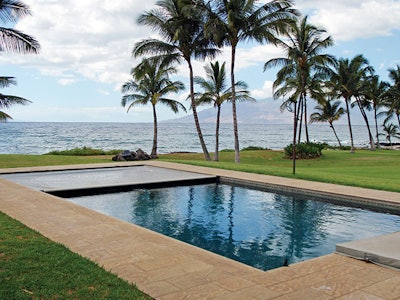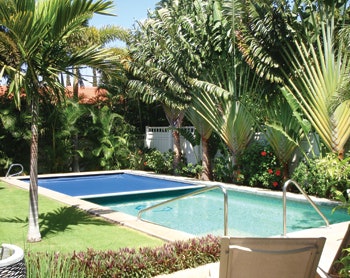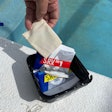
There’s so much good to say about automatic covers, let’s get the negatives out of the way first. The downsides really boil down to two things: First automatic covers are expensive, depending who you ask and the product being used, an automatic cover might add anywhere from $10,000 to $20,000 to a residential pool or more in some of the trickier applications.
Secondly, covers compromise aesthetics. In most cases, they limit the shape of the pool to a rectangle, which for many people isn’t much of a problem because rectangular pools are often among the most beautiful across a range of settings. More intrusive still, even if the cover has an attractive color, it’s never going to be as eye pleasing as a shimmering body of water.
Both the cost and aesthetic issues are significant, yet the upsides so dramatically outweigh those issues, for many people such caveats are easily and quickly dismissed.
Comfortable Skin
One of the interesting things about covers is that for the most part, they really haven’t changed much in recent years. Sure, there have been incremental improvements in the motor technology, vault-concealment schemes and track systems, and they come in more colors than they used to, but by and large, the products have remained basically the same.
The reason for this lack of major innovation is not due to a deficit of creativity among cover manufacturers, but arguably because covers are relatively simple in nature and for decades now, they’ve done exactly what they’re meant to do.
"It’s true, the heart and soul of automatic cover technology hasn’t changed all that much," admits Tom Dankel, vice president of Aqumatic Pool Covers (Gilroy, Calif.). "It’s not like the electronics industry where you see changes almost every week.
"Most of the development has been in the extrusion technology, which has opened up application possibilities across the spectrum of swimming pool types. Where once automatic pool covers were strictly the domain of concrete pools, now they’re easily applied to fiberglass and vinyl pools, but that’s not really anything new at this point."
According to Dankel, the most recent development, at least where his company is concerned, involves fitting covers for swim spas. "We reshaped the system to fit swim spas without sacrificing the proven technology we’ve had for years with our hydraulic system," he explains.
In discussing covers with manufacturers and their dealers, the conversations quickly turn into feel-good exercises figuring out which benefits are the most meaningful to consumers. Unlike so many other facets of the pool and spa industry where technical and even philosophical debates have gone on for years and years, the case with covers is almost unequivocally positive.
"I love covers," says Kevin Woodhurst, a veteran designer and builder working in the Phoenix area. "There’s really no downside, they are extremely effective where safety is concerned, they provide huge environmental benefits and they provide a rapid return on investment in most cases. If I had my way, every pool would be equipped with a cover."

Safe Waters
Woodhurst is far from alone in his categorical enthusiasm for covers, and for very good reasons. Beginning with safety, specifically preventing child-drowning incidents, automatic covers have a stellar reputation for the simple reason that when properly installed, undamaged and in the closed position, it is impossible to fall into the water.
These days, most authorities on the subject, including the U.S. Consumer Product Safety Commission and other safety advocates across the spectrum, strongly recommend using layers of protection with parental supervision topping the list. Within this often-turbulent ongoing dialogue on the subject, there is near universal agreement that approved automatic safety covers are one of the layers consumers should consider when buying a pool or spa.
"Based on my experience with automatic covers, the primary reason that people buy is still because they have concerns about the safety of their young children, or grandchildren," says Pete Cattano, president of Paco Pools and Spas, a builder on Long Island, N.Y. "Automatic covers are a fantastic layer of protection because when they’re closed, there’s no way a child will drown in the pool, barring some highly unusual situation. It’s really just common sense."
These days, with the aging baby boomers seeking greater opportunities to socialize at home with friends and family, the desire for a safe environment, especially where children are concerned, drives many of their key decisions when considering purchasing a pool, to the point where many wouldn’t consider owning one without a safety cover of some kind.
"I recently spoke with a doctor I built a pool for years ago," recalls Cattano. "He’s now retired and has grandchildren that visit on a regular basis. The pool we built originally was free-form and still in good shape. But because he and his wife have these young kids around, they want us to rip the original pool out and put in a rectangle so they can have a cover. In other words, the desire for the safety a cover provides is driving the decision to build a new pool."

Saving Energy
The case for automatic covers becomes even stronger when taking into account their ability to save energy, which has multiple positive ramifications.
"For a long time, safety was the issue that motivated most people to look at an automatic cover and for many that hasn’t changed," explains Dankel. "These days, however, we see far greater concerns over energy savings, which are dramatic. People like the idea of using less energy because of concerns over the environment and they obviously want to save money. It’s always been easy to calculate the energy savings and it’s always been extremely significant, but there was a time when that mostly fell on deaf ears. That’s changed in a big way."
Covers save energy in a number of ways. First, they dramatically reduce evaporation, which means it takes less energy to maintain pools at a comfortable temperature. This not only saves money, but also extends the swimming season.
"I’d say probably 80 percent of the pools we build include an automatic cover," explains Tony smith, service manager for Platinum Poolcare Aquatech of Chicago, a firm that builds and services pools. "Here in the Midwest, the energy savings are particularly important, especially for people who enjoy using their pools on a regular basis. We have a number of customers who keep their pools open year-round. They wouldn’t be able to do that without a cover."
Reducing evaporation has the added benefit of conserving water, which is becoming more and more of an issue in arid climates, especially those experiencing population growth. "There was a time when most people if not everybody took the availability of potable water at the tap for granted," adds Woodhurst. "Those days are long gone. In places like California and Arizona, water shortages are reaching critical levels. Covers are a great way to help conserve this incredibly valuable resource."
Another way that covers conserve energy comes by way of drastically reducing the amount of time the circulation system runs. "Typically in California an uncovered pool might run eight hours per day," explains Dankel. "With a cover you’re looking at two hours a day. That’s a 75 percent saving in terms of energy used to filter and treat the water. You extend that over six months, a year or two years and those dollars are going to add up in a hurry."
And with reduced operating hours, equipment lasts longer — pumps and motors are replaced less often, filters require less frequent cleanings or backwashing, which in the case of D.E. or sand filters, also conserves water. "There’s a real ripple effect with these benefits," adds Dankel. "You’re going to reduce chemical use, decrease downtime, as well as save water and energy."
Also, because dirt and debris don’t find their way into the water when the cover is closed, there can be dramatically reduced costs in service routines. "Reduced maintenance is a big advantage," confirms Smith. "Chlorine isn’t used as fast because there’s less contamination entering the pool and the sunlight is not coming in, which of course destroys your chlorine residual."
Such savings increase dramatically when covers are used with indoor pools. According to Kevin Ruddy, president of Omega Pool Structures, a firm specializing in indoor pool systems located in Toms River, N.J., automatic covers are so beneficial indoors that he is reluctant to work on projects without them. "We recommend automatic covers for every indoor pool we design," he says. "By reducing evaporation you not only save money on heating costs, but don’t have to run the dehumidification system when the pool is covered. We’ve found that covers can reduce energy consumption anywhere from 65 to 70 percent."
Taking into account the energy savings, how fast do most automatic covers pay themselves? "There are a number of variables that come into play," says Dankel, "but overall, we can safely say that most covers will pay for themselves easily within five to six years."
Experience Factors
If the dramatic benefits of safety, energy savings, extended swimming seasons and water conservation weren’t enough, automatic cover advocates point out that the systems enhance the pool ownership experience – perhaps the ultimate benefit of them all.
"Aside from people who use swimming as a regular form of exercise, for most people, swimming is an impulse activity," observes Dankel. "With an automatic cover, on a moment’s notice you can go out to the pool, retract the cover and have a pool that is warm and clean. You don’t have to net the pool and it’s going to be a comfortable temperature.
"Let’s face it, water that is cold and dirty is not inviting. In our company, we like to say, ‘skim less and swim more.’"
Comments or thoughts on this article? Please e-mail [email protected].








































